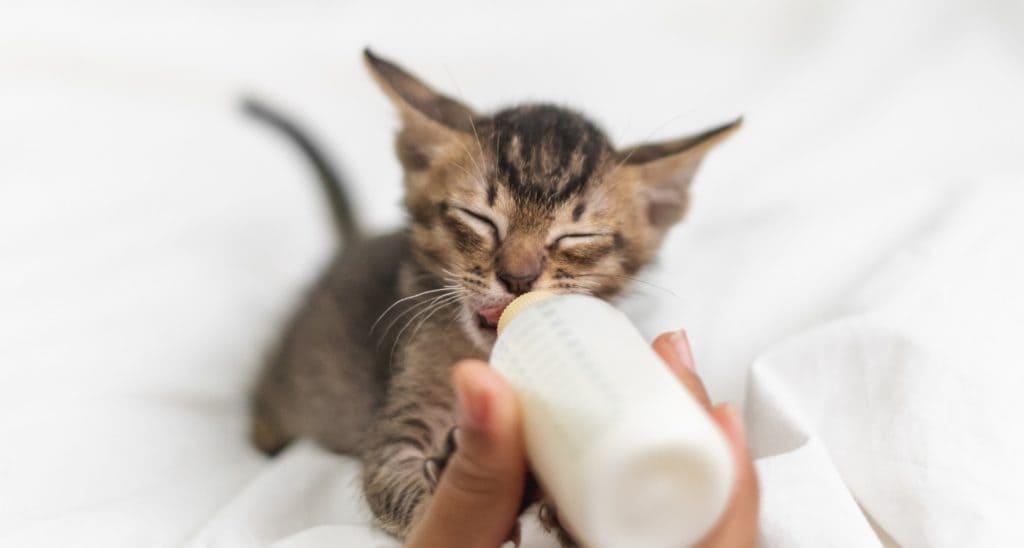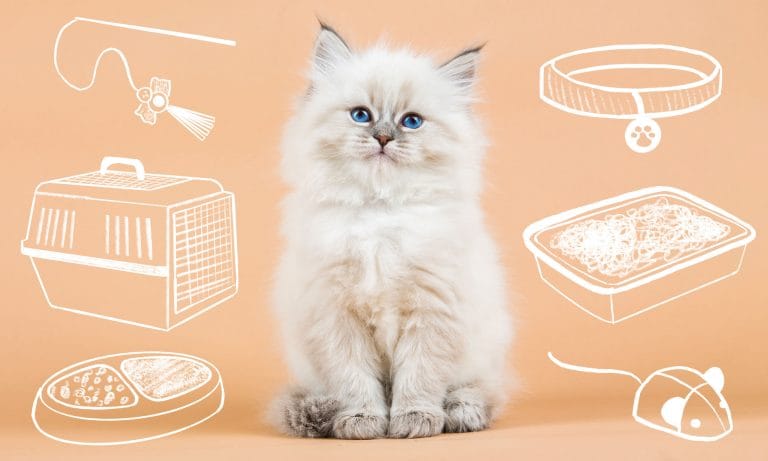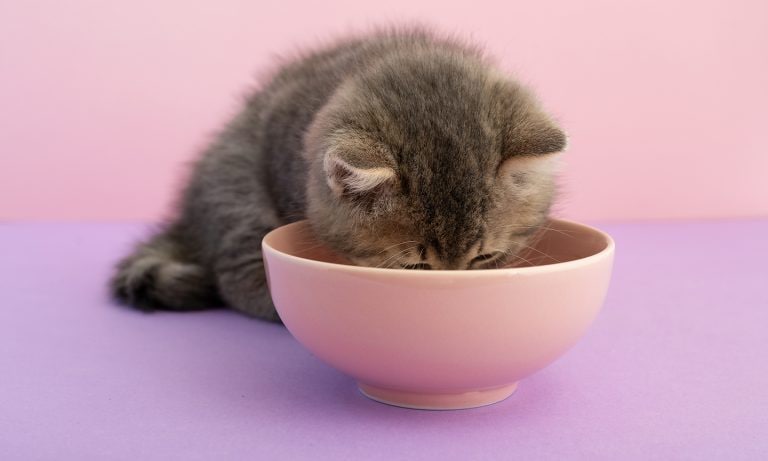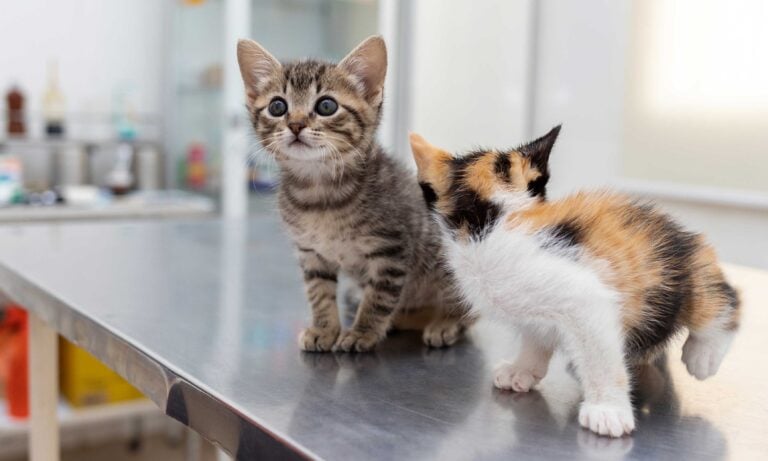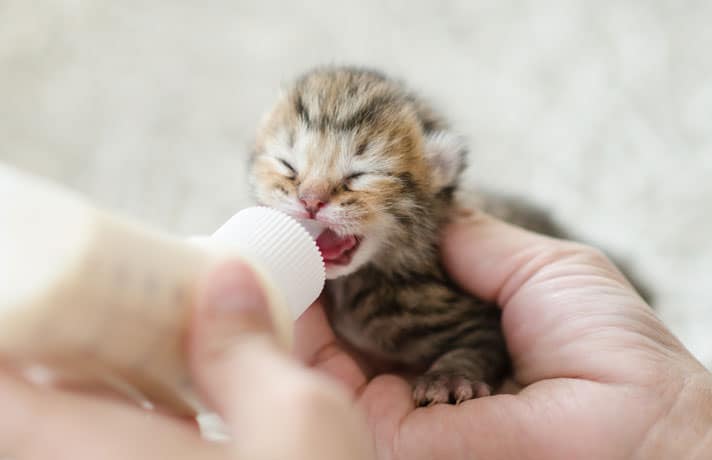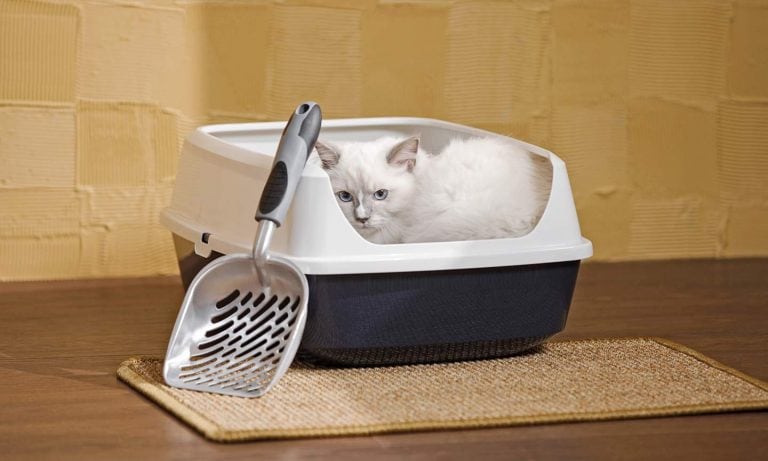We all know that good nutrition is vital to our cats’ health and wellbeing throughout their lives, but determining what to feed kittens is especially important.
Growing from a 4-ounce newborn kitten to a full-grown adult takes energy, proteins, fats, vitamins, minerals and more—all in just the right amounts and proportions to avoid potentially dangerous nutritional deficiencies and excesses.
Read on to learn how and what to feed kittens so they can get the nutrients they need to grow into happy and healthy adult cats.
What To Feed Newborn Kittens From Birth to 4 Weeks of Age
The best food for kittens from birth up to around 3 or 4 weeks of age is their mother’s milk. You simply can’t beat nature! This is especially true during the first day of life.
The milk that mothers initially produce is called colostrum. It is extremely nutrient dense and even contains antibodies (disease fighting proteins) that help protect kittens against infectious diseases. After kittens are 1 or at most 2 days old, they can no longer absorb antibodies through their intestinal tract.
Thankfully, most queens (the official—and perfect—name for female cats) are excellent mothers and will provide their newborn kittens with all the care they need. The best way to check that kittens are getting adequate nutrition during this time is to weigh them daily. In general, kittens should gain approximately ½ to ¾ of an ounce (15-20 grams) each day. Momma cats should have 24/7 access to fresh water and a cat food labeled for growth and reproduction or all life stages so they can produce enough milk for their litters.
When Bottle Feeding Kittens Becomes Necessary
At times, a kitten’s diet needs to be supplemented with or switched to a milk substitute designed specifically for cats. With especially large litters, you may want to give the smaller or less assertive kittens time alone with the queen so they have easier access to the best food available—mom’s milk. Bottle feed the kittens who are growing the fastest at this time so they don’t go hungry. Feral kittens under the age of four weeks who no longer have access to a nursing mom will also need to be bottle fed.
Do not feed newborn kittens cow or goat milk or human or dog formula; only a milk replacer made specifically for kittens will provide appropriate nutrition. Talk to your veterinarian if you are concerned that a kitten is failing to nurse, grow, or develop as expected.
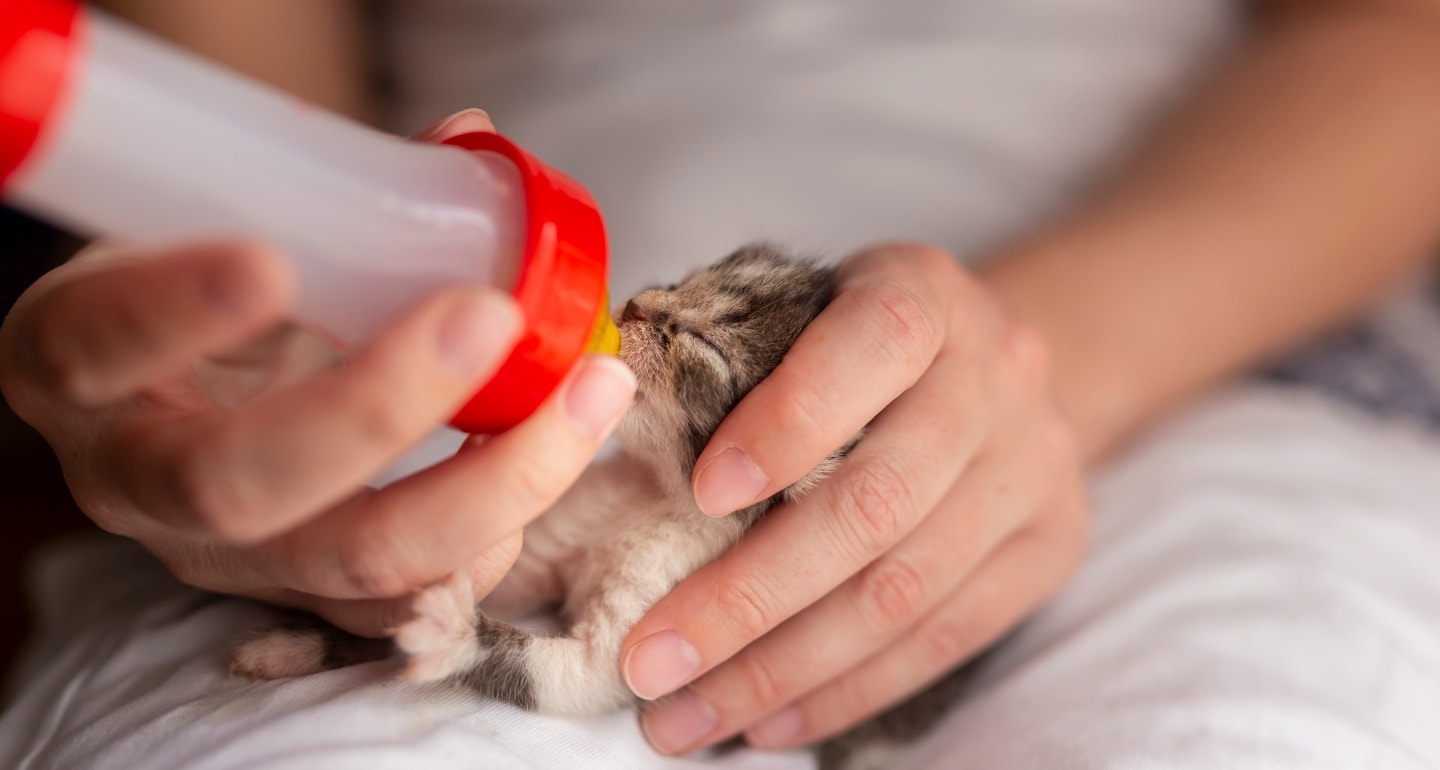
iStock.com/vladans
How To Feed Kittens With a Bottle
Bottle feeding kittens may not be the easiest option when they are very young. Many people find that an eye dropper or small syringe works best at first. Once kittens are a bit older, you may still need to try several different nipple styles before you find the one that your kitten uses best.
When you’re ready to feed, first make sure the kitten is warm. If their ears, feet or mouth are cool to the touch, they could be hypothermic and unable to digest their food. Under normal circumstances, kittens will snuggle up with their mom and littermates, but hand-raised kittens don’t have this natural source of warmth. They must be housed in a warm, draft-free environment with adequate bedding and access to a safe, hot water bottle or heating pad.
Next, place the kitten on a towel on your lap in a normal, belly down position. Never feed a kitten on their back because they may inhale rather than swallow the milk! Support the back of the head with one hand while you guide the nipple into the mouth with the other. Hold the bottle in a tipped position so any air inside is at the point farthest away from the nipple. Watch or gently feel the kitten’s throat to ensure they are suckling and swallowing. Your veterinarian can give you tips on bottle feeding kittens if you run into trouble.
Newborn kittens will need to be bottle-fed about once every two to three hours. This kitten feeding schedule can generally be stretched out to every three or four hours fairly quickly. Follow the instructions printed on the label of your kitten’s milk replacer. Powdered milk replacer should be mixed with warm water immediately before feeding. Premixed formulas can be heated to body temperature by placing them in a cup of warm water. Let kittens nurse until their suckling slows and be sure to perform daily weight checks.
Young kittens also need help urinating and defecating. After every feeding, wipe around their anus and penis or vulva with a warm, damp cloth to stimulate them and then clean them up well. Keep a shallow litter box in the kitten enclosure (a small cookie sheet works well). Once they start using it regularly, you no longer need to stimulate them to urinate and defecate.
What To Feed Kittens 4 To 6 Weeks of Age — Weaning Begins
Weaning is the gradual transition from a diet of only mother’s milk or an appropriate milk replacer to solid foods. For kittens, this generally begins around 3 to 4 weeks of age.
Start by offering a gruel made from high-quality canned kitten food mixed with warm water several times a day. Also put out a small bowl of water. For large litters, set up several feeding stations to ensure that everyone has access to what they need.
Bottle-fed kittens will let you know that they are ready to try solid food when they start chewing on the nipples while they nurse. Initially, continue to offer a bottle every 6 to 8 hours while food is freely available, but once the kittens are eating canned food well and drinking water from a bowl, you can stop the bottle feedings.
By 5 to 6 weeks of age, kittens should be able to eat canned food without added water because their baby teeth are more fully erupted. (Read more about kitten’s teething here.)
What To Feed Kittens 6 To 10 Weeks of Age — Weaning Comes To an End
Mom cats usually start to drastically limit their kitten’s access to milk at around 6 weeks of age. When they are 8 to 10 weeks old, most kittens are fully weaned and eating only solid food and drinking water. Bottle-fed kittens can be transitioned a little quicker—full weaning by 6-8 weeks is reasonable.
So, what should you feed your kitten toward the end of weaning? Canned kitten food is still the best option—but if you want to switch to or add dry kitten food, start by soaking it in some warm water. Food and water should always be available to young kittens to fuel their rapid growth and development.
Whenever possible, kittens should remain with their mother and littermates until they are at least 8 weeks old. These first two months are vital from both a nutritional and a behavioral standpoint.
What To Feed Kittens 10+ Weeks of Age — A Kitten’s Diet After Weaning
Most kittens need to continue eating foods designed specifically for growth until they are around 10 months of age. Only feed your kitten commercial diets that meet (ideally exceed) the standards put forward by the Association of American Feed Control Officials (AAFCO). Look for a statement on the product’s label that says something along the lines of:
- Kitten Food A is formulated to meet the nutritional levels established by the AAFCO Cat Food Nutrient Profiles for growth and reproduction.
or
- Animal feeding tests using AAFCO procedures substantiate that Kitten Food B provides complete and balanced nutrition for growth and reproduction.
Try these vet-recommended wet kitten foods:
Try these vet-recommended dry kitten foods:
If you are interested in feeding a home-prepared diet, only do so with input from a veterinary nutritionist. Nutritional imbalances can be especially catastrophic when they occur while a kitten is still growing and developing. Most recipes that are available online or in books have been found to provide inappropriate nutrient levels.
The Importance of Protein for Kittens
Kittens and cats are true carnivores. They have unique nutritional needs—like dietary sources of taurine (an amino acid), vitamin A, vitamin D, arachidonic acid and an increased demand for many B vitamins. These can all be met by a diet that is rich in animal tissue.
Because of their rapid growth and development, kittens need even more protein than do adult cats. The AAFCO minimum protein level for kitten foods is 30 percent while it is 26 percent for adult maintenance.
High-quality kitten foods have meat/fish and meat/fish meals at the top of their ingredient lists. Plant-based sources of protein, like peas or soy, and carbohydrates, like corn, rice or potatoes, should only be included in kitten foods in small amounts, if at all. Wet foods tend to be higher in protein and lower in carbohydrates in comparison to dry foods.
A good kitten food will provide all the nutrients that a healthy kitten requires. Dietary supplements are not necessary and can actually be harmful if they lead to nutrient excesses or imbalances.
The Importance of Water for Kittens
Domestic cats evolved from desert-dwelling ancestors who got most of their water from the food they ate. Kittens and cats aren’t well designed to drink water from bowls and may exist in a perpetual state of mild dehydration when their food does not contain much water. Most veterinarians now recommend that wet foods make up most if not all of a cat’s diet.
If you choose to feed your kitten dry food, it’s especially important to provide lots of fresh, clean water. Some cats prefer to drink from running sources of water, like pet water fountains. Hydration supplements are also available for cats.
How Often To Feed a Kitten
The most common nutritional disease of cats is obesity. In most cases, a kitten’s growth rate and need for extra calories declines around 6 months of age, which makes overfeeding more likely. Cats who are spayed or neutered also have reduced caloric needs in comparison to intact individuals. For these reasons, it’s generally a good idea to stop leaving food out all the time and switch to a kitten feeding schedule with measured meals when kittens are 4 to 6 months old.
Cats are designed to eat multiple small meals a day. A 4- to 6-month-old kitten’s food should be divided up into at least three meals a day. Older kittens and cats can handle being fed roughly every 12 hours, but more frequent, smaller meals are even better. Try placing small meals in several locations around your house to encourage exercise or use an automatic timed feeder when you will be gone for extended periods of time.
How Much To Feed a Kitten
Once you make the switch from free-feeding to meal-feeding, you need have a general idea of how much food to feed a kitten each day. Kitten feeding guides and calorie counts are printed on kitten food labels. (To get an idea of the best serving size for your kitten, check out our guide on how much to feed kittens.)
Keep in mind that kittens are all individuals, and their caloric needs can vary wildly. For example, a very active and rapidly growing large breed kitten will need more food than will an older, relatively inactive small breed kitten even if they both weigh 4 pounds.
Kittens should remain slim, but it can be hard to recognize what normal looks like when so many pets are now overweight. All but the youngest of kittens should have an observable waist when looked at from above, and it should be easy to feel their ribs with gentle pressure. Use a body condition scoring system to monitor your cat’s weight and adjust the amount of food you offer accordingly.
When To Switch From Kitten Food To Adult Cat Food
Kittens should be switched to an adult cat food when they have reached their full adult height, even if they still have some filling out to do. For most cats, this occurs around 10 months of age. Especially large-framed cats tend to stop growing later and may need to eat kitten food until they are a bit older. Petite cats or kittens who are gaining too much weight on kitten food may need to make the switch a little earlier.
Read More
Share:
